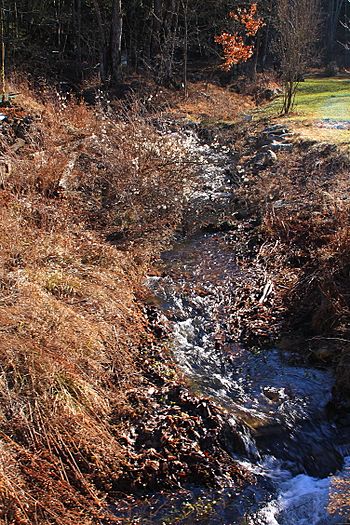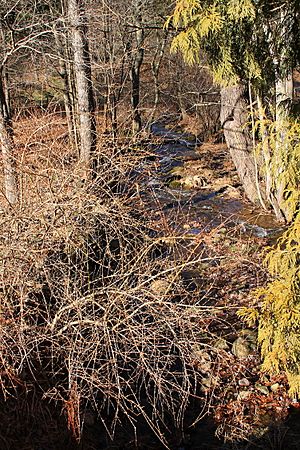Fallow Hollow facts for kids
Quick facts for kids Fallow Hollow |
|
|---|---|

Fallow Hollow looking upstream
|
|
| Physical characteristics | |
| Main source | pond in Sugarloaf Township, Columbia County, Pennsylvania 1,220 to 1,240 feet (370 to 380 m) |
| River mouth | Coles Creek in Sugarloaf Township, Columbia County, Pennsylvania 994 ft (303 m) |
| Length | 1.5 mi (2.4 km) |
| Basin features | |
| Progression | Coles Creek → Fishing Creek → Susquehanna River → Chesapeake Bay |
| Basin size | 0.96 sq mi (2.5 km2) |
Fallow Hollow is a small stream, also known as a tributary, located in Columbia County, Pennsylvania. It flows into Coles Creek. This stream is about 1.5 miles (2.4 km) long and runs through Sugarloaf Township.
The area of land that drains into Fallow Hollow, called its watershed, covers about 0.96 square miles (2.5 km2). Fallow Hollow is considered a "Locally Significant Area" by the Columbia County Natural Areas Inventory. It is also known for its wild trout, being listed as "Class A Wild Trout Waters."
Contents
The Journey of Fallow Hollow: Its Course
Fallow Hollow begins its journey in a pond within Sugarloaf Township. This starting point is close to Ranch Road.
The stream first flows generally south for a short distance, less than half a mile. Then, it changes direction and turns to flow west. After flowing west for a bit, it turns again, heading northwest. Here, it starts to flow alongside Ripple Brook Road.
A little further downstream, Fallow Hollow reaches its end. It joins Coles Creek. This meeting point is about 2.54 miles (4.09 km) upstream from where Coles Creek itself ends.
Understanding Fallow Hollow's Environment
Where is Fallow Hollow Located?
The land around the mouth of Fallow Hollow is about 994 feet (303 meters) above sea level. Where the stream begins, its source, the elevation is higher. It is between 1,220 feet (370 meters) and 1,240 feet (380 meters) above sea level.
The entire area that drains into Fallow Hollow, its watershed, covers about 0.96 square miles (2.5 square kilometers). All of Fallow Hollow flows through land that is privately owned.
What Kinds of Habitats Are Found Here?
The watershed of Fallow Hollow is home to many different types of natural areas. These include a pond where the stream starts and a shrub swamp. There is also a forested ravine and an open area with grasses and other small plants.
Another interesting habitat is a wet, deciduous forest. This forest has a very thick understory, which means the plants growing beneath the main trees are very dense. Many ferns grow here.
The water in Fallow Hollow has a total concentration of alkalinity of eight milligrams per liter.
The Story of Fallow Hollow: History and Name
What Does "Fallow Hollow" Mean?
The exact meaning or origin of the name "Fallow Hollow" is not known.
Protecting the Environment of Fallow Hollow
In 2004, the Columbia County Natural Areas Inventory made some recommendations for Fallow Hollow. They suggested that the areas along the stream, especially around the wetlands, should not be disturbed. These areas are called riparian buffers.
The inventory also advised against bringing beavers into the area. They also thought that more deer hunting might be helpful for the local environment. Fallow Hollow is listed as a "locally significant site" because of its importance to the natural environment in Columbia County.
Plants of Fallow Hollow: A Green World
Trees and Ferns in Higher Areas
In the higher parts of Fallow Hollow's watershed, the main trees in the forest canopy include red maple, sugar maple, red oak, white oak, yellow birch, serviceberry, Eastern hemlock, and big-tooth aspen.
Underneath these tall trees, the understory is filled with plants like northern lady fern, hay-scented fern, New York fern, common wood fern, and starflower.
Wetland Plants and Seepy Woods
The wetlands of Fallow Hollow are home to many different shrubs and herbaceous plants. You can find plants such as sensitive fern, highbrush blueberry, cinnamon fern, winterberry holly, and various types of sedges.
The wet, seepy woods in the hollow have trees like white pine, yellow birch, eastern hemlock, and pignut hickory. Other plants growing in this part of the hollow include Japanese barberry, lowbush blueberry, partridge berry, red trillium, Indian cucumber, and witch hazel.
Animals of Fallow Hollow: Wildlife and Fish
Bird Life and Other Animals
Fallow Hollow has a good variety of bird species, showing high biodiversity. Many different birds live here. These include four types of warblers and two types of vireos. You can also find two kinds of sparrows.
Other common birds in the hollow are the black-capped chickadee and pileated woodpeckers. The watershed of Fallow Hollow has a lot of deer. Sometimes, there are so many deer that they eat too much of the plants, which is called over-browsing.
Fish and Trout Reproduction
The entire watershed of Fallow Hollow is known as a Coldwater Fishery. This means its waters are cold enough for fish that prefer cooler temperatures. It is specifically used as a High-Quality Coldwater Fishery.
The stream's watershed is also designated as "Class A Wild Trout Waters." This is important because Trout (especially brook trout) naturally reproduce in the stream. They lay their eggs and new trout hatch all along the stream, from its beginning to where it joins Coles Creek.


